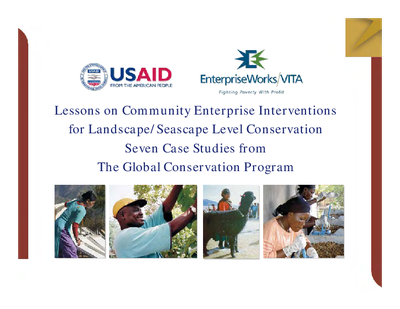Lessons on Community Enterprise Interventions for Landscape/Seascape Level Conservation: Seven Case Studies from the Global Conservation Program

Key points in document
- This report synthesizes findings from the Global Conservation Program, which included seven different landscape or seascape projects implemented by six NGOs in eight countries.
- Three learning themes were addressed in the review of the seven case studies: (1) How has using a threats-based approach influenced engagement with community enterprise interventions? (2) How has the shift in scale to landscape/seascape level conservation influenced choices in enterprise development? (3) How has the Global Conservation Program leveraged partnerships and cross-sectoral relationships to achieve livelihood/economic outcomes that support conservation at a landscape/seascape level?
- The report provides lessons on building the following enabling conditions: diversification of livelihoods, equitable benefit sharing, established resource rights, supportive policies and legal frameworks, and both local and national business alliances and partnerships.
- The report provides detailed examples drawn from the diverse set of case studies of the lessons learned around each of these enabling conditions.
- This review was developed by USAID’s Sustainable Coastal Communities and Ecosystems (SUCCESS) project, implemented between 2004 and 2008.
Information relevant to Learning Questions:
Are enabling conditions in place to support a sustainable enterprise?
- Stakeholder alignment, diversification
- Market demand, profit potential, access to credit/capital
- Ownership, governance
- Government requirements, policies for enterprises, business alliances
- Financial management capacity, technical capacity
- Equipment, infrastructure
- Benefit sharing, targeted participants, combined strategic approaches, biodiversity linkage, policies for and enforcement of resource use, planning for external disturbance
Does the enterprise lead to benefits to stakeholders?
- Increased income for participants
Do the benefits lead to positive changes in attitudes and behavior?
- Attitudes regarding sustainable use of resources
- Behaviors regarding sustainable use of resources
Does a change in stakeholders’ behaviors lead to a reduction to threats to biodiversity (or restoration)?
- Agriculture and aquaculture
- Energy production and mining
- Biological resource use
- Human intrusions and disturbance
- Climate change and severe weather
Does a reduction in threats (or restoration) lead to conservation?
- Forest ecosystems
- Freshwater ecosystems
- Grassland ecosystems
- Marine ecosystems
- Species

